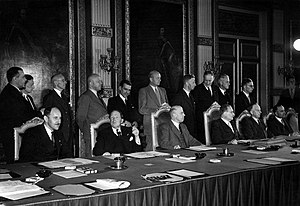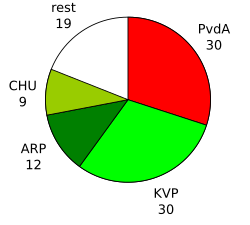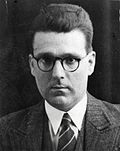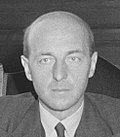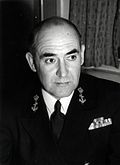
Jelle Zijlstra was a Dutch politician of the Anti-Revolutionary Party (ARP) and economist who served as Prime Minister of the Netherlands from 22 November 1966 until 5 April 1967.

Willem Drees Sr. was a Dutch politician of the Social Democratic Workers' Party (SDAP) and later co-founder of the Labour Party (PvdA) and historian who served as Prime Minister of the Netherlands from 7 August 1948 to 22 December 1958.

Jozef Maria Laurens Theo "Jo" Cals was a Dutch politician of the Catholic People's Party (KVP) and jurist who served as Prime Minister of the Netherlands from 14 April 1965 until 22 November 1966.
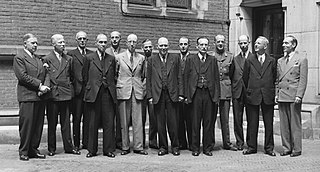
The Schermerhorn–Drees cabinet was the executive branch of the Dutch Government from 25 June 1945 until 3 July 1946. The cabinet was formed by the christian-democratic Roman Catholic State Party (RKSP), the social-democratic Social Democratic Workers' Party (SDAP) and the social-liberal Free-thinking Democratic League (VDB) by royal decree following the end of World War II. The cabinet was a provisional centre-left grand coalition and had a substantial majority in the House of Representatives, with prominent civil engineer Willem Schermerhorn of the Free-thinking Democratic League serving as Prime Minister. Social Democratic Leader Willem Drees served as Deputy Prime Minister and Minister of Social Affairs.

The De Jong cabinet was the executive branch of the Dutch Government from 5 April 1967 until 6 July 1971. The cabinet was formed by the christian-democratic Catholic People's Party (KVP), Anti-Revolutionary Party (ARP) and Christian Historical Union (CHU) and the conservative-liberal People's Party for Freedom and Democracy (VVD) after the election of 1967. The cabinet was a centre-right coalition and had a substantial majority in the House of Representatives with prominent Catholic politician Piet de Jong the Minister of Defence in the previous cabinet serving as Prime Minister. Prominent Liberal politician Johan Witteveen a former Minister of Finances served as Deputy Prime Minister and returned as Minister of Finance, prominent Protestant politician Joop Bakker the Minister of Economic Affairs in the previous cabinet served as Deputy Prime Minister, Minister of Transport and Water Management and was given the portfolio of Suriname and Netherlands Antilles Affairs.

The Zijlstra cabinet was the executive branch of the Dutch Government from 22 November 1966 until 5 April 1967. The cabinet was formed by the christian-democratic Catholic People's Party (KVP) and the Anti-Revolutionary Party (ARP) after the fall of the previous Cabinet Cals. The caretaker rump cabinet was a centrist coalition and had a minority in the House of Representatives with former Protestant Leader Jelle Zijlstra a former Minister of Finance serving as Prime Minister and dual served as Minister of Finance. Former Catholic Prime Minister Jan de Quay served as Deputy Prime Minister and Minister of Transport and Water Management, Protestant Leader Barend Biesheuvel continued as Deputy Prime Minister, Minister of Agriculture and Fisheries and the responsibility for Suriname and Netherlands Antilles Affairs from previous cabinet.

The minister of foreign affairs is the head of the Ministry of Foreign Affairs and a member of the Cabinet and the Council of Ministers. The incumbent minister is Caspar Veldkamp of the New Social Contract (NSC) party, who has been in office since 2 July 2024. Regularly, a state secretary is assigned to the ministry who is tasked with specific portfolios, currently the function is not in use. Additionally since 1965 there has been a minister without portfolio assigned to the ministry, the minister for foreign trade and development cooperation has traditionally development cooperation as portfolio, since 2012 the portfolio of trade and export has been assigned added to the function.

The First Beel cabinet was the executive branch of the Dutch Government from 3 July 1946 until 7 August 1948. The cabinet was formed by the christian-democratic Catholic People's Party (KVP) and the social-democratic Labour Party (PvdA) after the election of 1946. The cabinet was a centre-left grand coalition and had a substantial majority in the House of Representatives with prominent Catholic politician Louis Beel serving as Prime Minister and dual served as Minister of the Interior continuing from the previous cabinet. Labour Leader Willem Drees continued as Deputy Prime Minister and Minister of Social Affairs from the previous cabinet. According to one study, “Beel was of the opinion that a joint KVP-PvdA program should be presented to other political groups. According to Beel, that program should be socio-economically progressive, that is to say reform-oriented in favor of broad layers of the population. The socialists should not have to fear that a conservative wing within the KVP would rule the roost.”

The First Drees cabinet, also called the Second Drees cabinet was the executive branch of the Dutch Government from 15 March 1951 until 2 September 1952. The cabinet was a continuation of the previous Drees–Van Schaik cabinet and was formed by the christian-democratic Catholic People's Party (KVP) and Christian Historical Union (CHU), the social-democratic Labour Party (PvdA) and the conservative-liberal People's Party for Freedom and Democracy (VVD) after the fall of the previous cabinet. The cabinet was a centrist grand coalition and had a substantial majority in the House of Representatives with Labour Leader Willem Drees serving as Prime Minister. Prominent Catholic politician Frans Teulings the Minister of the Interior in the previous cabinet served as Deputy Prime Minister and Minister without portfolio for the Interior.

The Third Drees cabinet, also called the Fourth Drees cabinet, was the executive branch of the Dutch Government from 13 October 1956 until 22 December 1958. The cabinet was a continuation of the previous Second Drees cabinet and was formed by the social-democratic Labour Party (PvdA) and the christian-democratic Catholic People's Party (KVP), Anti-Revolutionary Party (ARP) and the Christian Historical Union (CHU) after the election of 1956. The cabinet was a Centre-left grand coalition and had a substantial majority in the House of Representatives, with Labour Leader Willem Drees serving as Prime Minister. Prominent KVP politician Teun Struycken served as Deputy Prime Minister and Minister of the Interior, Property and Public Organisations.

The second Beel cabinet was the executive branch of the Dutch Government from 22 December 1958 until 19 May 1959. The cabinet was formed by the Christian-democratic Catholic People's Party (KVP), Anti-Revolutionary Party (ARP), and the Christian Historical Union (CHU) after the fall of the previous Third Drees cabinet. The caretaker cabinet was a centre-right coalition and had a slim majority in the House of Representatives with former Catholic Prime Minister Louis Beel returning as Prime Minister and dual served as Minister of Social Affairs and Health. Prominent Catholic politician Teun Struycken continued as Deputy Prime Minister and Minister of the Interior, Property and Public Organisations from previous cabinet and dual served as Minister of Justice.

The De Quay cabinet was the executive branch of the Dutch Government from 19 May 1959 until 24 July 1963. The cabinet was formed by the christian-democratic Catholic People's Party (KVP), Anti-Revolutionary Party (ARP) and Christian Historical Union (CHU) and the conservative-liberal People's Party for Freedom and Democracy (VVD) after the election of 1959. The cabinet was a centre-right coalition and had a substantial majority in the House of Representatives with prominent Catholic politician Jan de Quay the former Queen's Commissioner of North Brabant serving as Prime Minister. Prominent Liberal politician Henk Korthals served as Deputy Prime Minister, Minister of Transport and Water Management and was given the portfolio of Suriname and Netherlands Antilles Affairs.
Roman/Red is the nickname for a period in Dutch politics between approximately 1945 and 1958. This period was characterized by coalitions between the Catholic and social-democratic parties in the Netherlands and Belgium. "Roman" refers to the parties with Roman Catholic affiliation, and "red" refers to the colour associated with social democrats. During the Roman/Red period, the Catholic People's Party (KVP) and the social-democratic Labour Party (PvdA) formed the core of several 'Roman/Red' cabinets, led primarily by Willem Drees.

Gerardus Mattheus Johannes "Gerard" Veldkamp was a Dutch politician of the Catholic People's Party (KVP) and economist.

Julius Christiaan van Oven was a Dutch jurist and politician of the Labour Party (PvdA).

Nancy Sophie Cornélie "Corry" Tendeloo was a Dutch lawyer, feminist, and politician who served in the House of Representatives for the Free-thinking Democratic League (VDB) from 1945 until 1946 and then for the newly-formed Labour Party (PvdA) until her death in 1956. Born in the Dutch East Indies, Tendeloo studied law at Utrecht University, during which time she made contact with people within the women's rights movement. She became politically active in the 1930's and was elected to the Amsterdam City Council for the VDB in 1938. After World War II, Tendeloo was appointed a member of the House of Representatives for the VDB in the national emergency parliament, formed to rebuild the country and organise elections. In 1946, the VDB merged with other parties into the PvdA, which Tendeloo represented in parliament. She sat on two select committees and spoke in favour of women's rights issues.
